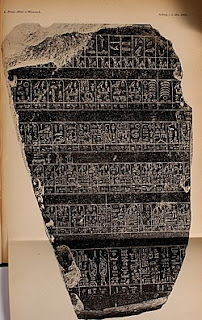This paper originally written as a discussion paper with informal citation.
ASH-3200: Ancient Near Eastern Societies
Dr. Tiffany Earley-Spadoni
University of Central Florida
 |
| Nergal of Larsa |
Magic and Medicine in the Ancient Near East
For the people of
the ancient Near East, the use of magic and medicine may not have been considered
separate fields to be used exclusive of each other. In fact, evidence suggests that the two were
likely intermingled to such a degree that it would be impossible to conduct
“healing” without both interacting together.
While the details of the form and purpose of magic may have varied from
culture to culture or across time periods, the use of magic as a primary
component of “medicine” is evidenced in both ancient Mesopotamia and ancient
Egypt. Magic for the people of the
ancient near east was not only often used as a complementary therapy of medicine
but was also employed as a necessary component of medicine.
In
ancient Mesopotamia, the concept of healing often combined the practical with
the mystical (E-S, Healing). There could
be many causes of illness and harm, and many of these were collected together
into books of therapy. One such was the Surpu
(Akkadian for “burning”). This text
described a number of conditions and the related ritual spells to be performed
to rid the patient of the undesired harm (E-S, Healing). There were many things that could bring about
illness, disease, or misfortune. Across
the region we can find evidence of magic used to reverse common illnesses,
witchcraft, and epidemics. All forms of
ritual healing involved some basic formulaic components: a description of symptoms, a diagnosis of
cause, a ritual incantation, a ritual action(s), and often an appeal to a
higher power (Schwemer, Witchcraft). Illness
or harm was often not considered just a “physical” problem. There usually was a
dual component of the physical along with the spiritual or supernatural,
whether that be divine, demonic, or witchcraft.
Therefore, healing necessarily included, as Earley-Spadoni indicated
earlier, both the practical and the mystical.
Sometimes the divine could be responsible for harm, as in the case of
the Hittite definition of epidemics, called the “devouring of God” found in the
Mari letters (Attia, Epidemics). At
other times, the demonic or spirits could be the culprit, as well as spells
cast by witches or warlocks. Common to
the healing component in both Mesopotamia and Egypt were the use of spells
(incantations) along with a physical relic of some sort: figurines, images, statues, stela, symbols,
and, especially in Egypt, names, and amulets.
The
belief in supernatural and magical forces in ancient Egypt often involved the
divine both in cause and solution more than it did in Mesopotamia. It goes to say that those solutions to
illness likewise entered more into the realm of the gods and goddesses. However, the magical formulation of spells
and actions were often very similar between the two. Like the Mesopotamians, the Egyptian ritual
formula for healing included the description of symptoms, diagnosis of cause,
ritual incantations and actions, and appeal to a higher power. In Egypt, magic, heka, was one of the
main forces used in the creation of the world (Pinch, Magic). Priests were the main practitioners of magic
and Sekhmet, the goddess of plague, was also the primary deity of healing. Lector priests were the considered the
highest users of magic, then, in descending primacy, came the scorpion-charmers,
midwives and nurses, and “wise women” (Pinch, Magic). There was a strong sense in Egyptian ritual
magic of the power contained in the word.
So much so that not only was there power in the spoken spell or
incantation, but also the written word.
Often, protective or healing spells were written into amulets that were
worn or written onto papyrus which were folded and worn, both for protection
and healing. In addition to the standard
ritual magic and protection spells, were the use of stela to transmit healing
power. This was often found on a cippus,
or stela with the image of the infant god Horus. Upon the stela were written various healing
spells. Water was poured over the stela
and drunk by the patient. It was
believed that the patient was then imbued with the healing power of the spell (Pinch,
Magic). Other practices related to
healing in ancient Egypt included the use of oracles, especially in relation to
the god Amenophis (McDowell, Religion, pg. 93), and the importance of household
cults dedicated to deceased ancestors, as evidenced in the worker’s community
at Deir el-Medina (McDowell, Religion, pg.104). Both of these were important components
related to healing. The use of oracles
was often employed to find out the cause of misfortune. And it was not uncommon for the living to ask
dead relatives to implore the gods for their intervention.
As
we can see, magic was a common and important component of life and healing in
the ancient world. As Tzvi Abusch
implies in The Witchcraft Series:
Maqlu, in both Mesopotamia and Egypt, magic was a “legitimate enterprise
as part of state religion” as well as accepted culture. She goes on to specify that while there was
those who practiced “black magic,” these were generally prohibited. A telling indicator of something that was
“missing” from the Mari archives, as noted by Attia in Epidemics in
Mesopotamia, is the conspicuous lack of request for doctors. Instead, in epidemics and other illnesses, what
was requested was exorcists and divinators.
The use of magic in the ancient Near East was not only a primary
component of healing, but I would also argue an indistinguishable part of medicine. The people of this time would not have
separated magic from medicine as two distinct fields.










